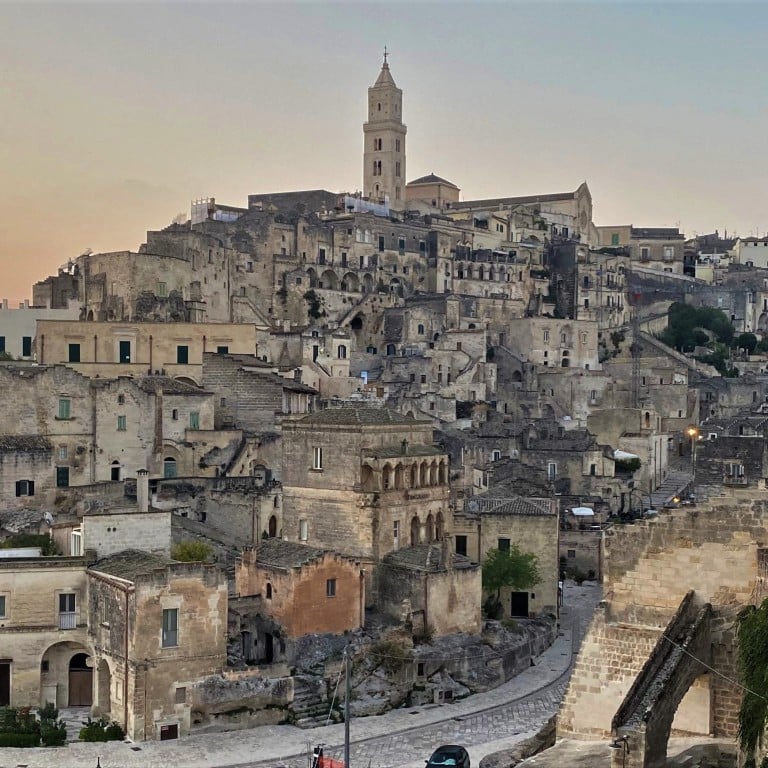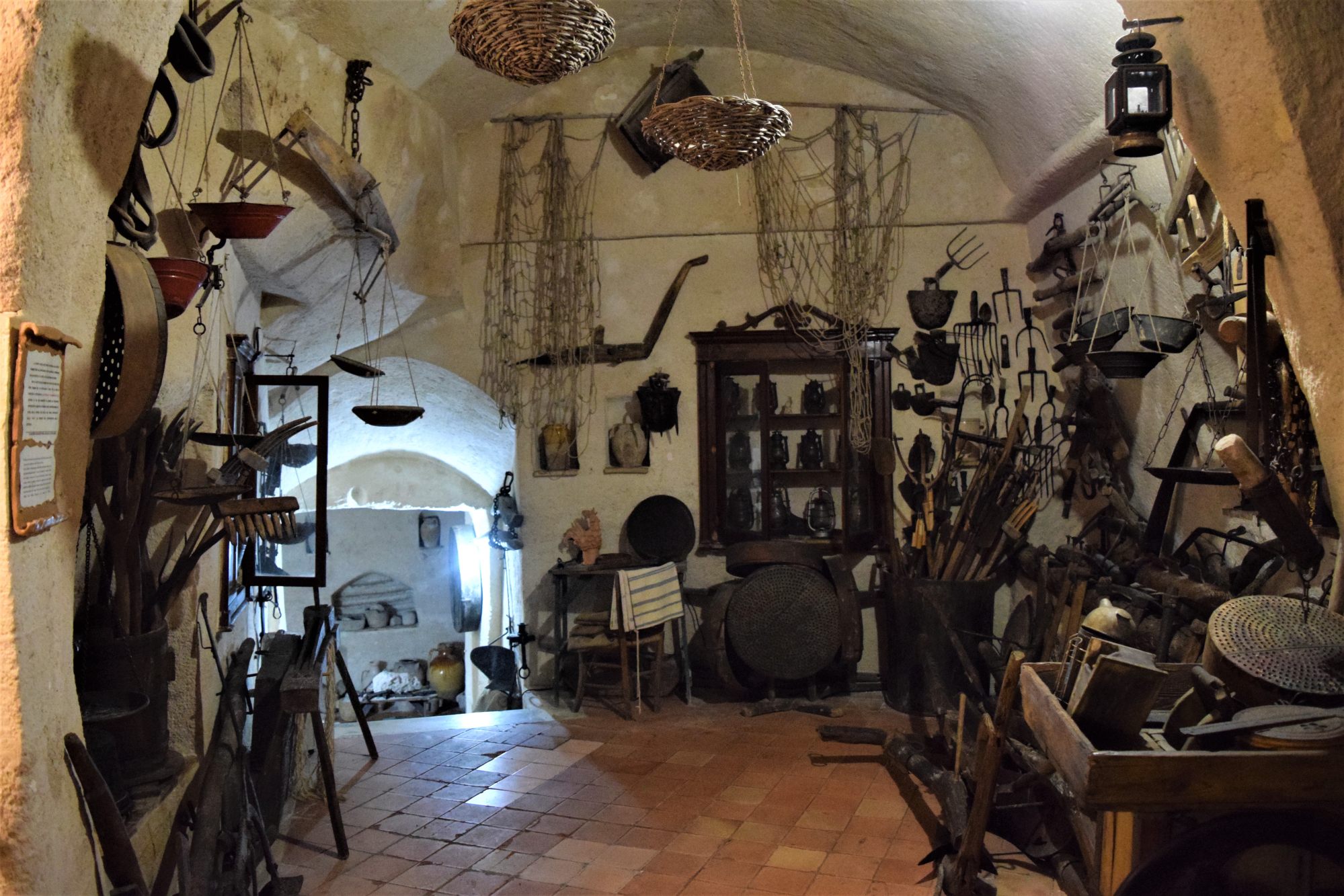
City in new James Bond movie No Time to Die is ‘Shame of Italy’ no more: how Matera left its dark days behind
- Matera, one of the most striking locations featured in the new 007 film, was once a byword for poverty, infant mortality and medieval levels of disease
- When James Bond came to town, the collision of Italy’s oldest civilisation with the demands of a Hollywood blockbuster brought surreal moments of light relief
“One of the most spectacular scenes for the film was shot outside the place where my father was born,” she says, proudly. “I tried to explain what was happening but he didn’t really understand.”
His bewilderment is understandable. After all, Matera – clinging to a craggy hillside above a wild and barren landscape in southern Italy – is one of the last places Daniel Craig would be greeted with the words: “We’ve been expecting you, Mr Bond.”
Home to troglodyte cave dwellers for 9,000 years and site of the country’s first-known human habitation, Matera was labelled “the Shame of Italy” in the 1950s, when its residents were found living in shockingly backward and unsanitary conditions.
Some 15,000 people lived in the cave homes cut into the city’s harsh hillsides, with livestock and families squeezed into cramped spaces without natural light, electricity or water. Matera became a byword for poverty, infant mortality and medieval levels of disease.
Residents of the old city – called the Sassi, from the Italian word for stone – were hurriedly evacuated to a bland and functional new city centre of modern residential blocks a mile away. Officials even considered walling off the ancient quarter to keep it forever out of sight.
Five-star hotel accepts bitcoin and ethereum to woo ‘clients of the future’
Abandoned, the Sassi became a ghost town of deserted homes, vagrants, fugitives and prowling packs of wolves, with many relocated residents too ashamed to ever set foot back on the weed-strewn streets of their brutal past.
A new generation of younger evacuees with different ideas rebelled against the indifferent tide of history sweeping over the Sassi, however – and in the 1990s, the stirrings of a tentative revival began as cave homes were renovated to become cafes and boutique hotels.
That transformation gathered pace as tourists flooded in following the filming of Mel Gibson’s The Passion of Christ in Matera in 2004 – and now the rehabilitation of the city has been supercharged by its starring role in one of the biggest films of 2021.

For two exhilarating months in the late summer of 2019, residents were shaken and stirred as the city filled with film crews and Hollywood stars, and Aston Martins and motorbikes screeched through the narrow stone streets of the Sassi for the US$270 million production.
Locals dashed from one location to another as they swapped news of sightings of Craig and pulled out mobile phones to record shoot-outs and car chases, including the jaw-dropping scene featured in the movie’s trailer wherein James Bond vaults a high city wall on a motorbike.
For older residents, it was a summer that turned history on its head. “Just imagine how it was for people born in a place which was known as the ‘Shame of Italy’ to see these incredible things happening in front of their caves for a famous movie,” Cappiello exclaims.

Today, the international profile of Matera could scarcely be further removed from its image a century ago, when it was chosen as a prison for political prisoners under Benito Mussolini’s fascist regime – a desolate city lost in an unescapable plain of death.
The city’s reputation was cemented in a 1945 memoir by the author and political exile Carlo Levi, who compared the Sassi to a scene from Dante’s Inferno and described the Basilicata region as a pagan, lawless place where shepherds communed with wolves.
Fast forward 75 years and Matera is a European Capital of Culture and one of the most astonishing rags-to-riches stories in global tourism – as well as probably the only city in Europe where you can book a room first occupied by humans 9,000 years ago.


Craig is said to have stayed at the five-star Palazzo Gattini hotel, in the heart of the Sassi – which on its website describes Matera as a Unesco-protected wonder that has gone from being “a place of shame to our national pride”. Booking a suite there this month would cost upwards of €780 (US$910) a night, while a suite crafted from an old cave home in the nearby Palazzo del Duca Matera, where Craig reportedly did his morning workouts, costs €280 a night.
For visitors not in the Hollywood A-list income bracket, renovated cave homes in the Sassi – complete with air conditioning, Wi-fi and patios for sunset cocktails – are available on Airbnb for about €100 a night.

The ravine around the old city is dotted with 1,500 cave dwellings dating to the Palaeolithic era, while an intricate network of underground cisterns has been found. A 16th century complex beneath the main plaza with chambers 15 metres deep was rediscovered in 1991.
When 007 swaggered into town, the noisy collision of Italy’s oldest civilisation with the brash production demands of a Hollywood blockbuster brought surreal moments of light relief to a city still emerging from obscurity. A shoot-out between Bond and baddies was being filmed outside a church when Cappiello took her elderly mother to mass.
“You couldn’t hear the priest because of the noise of gunfire outside and the priest had to stop every few minutes until it stopped,” she recalls.

A flock of sheep were kept in the old city for inclusion in a chase scene in which Bond, in his Aston Martin, finds his escape path blocked by livestock.
“The sheep were kept underneath my friend’s house for 10 days and the smell was terrible,” Cappiello says. “They didn’t clean the cave until a few days before the arrival of Daniel Craig and then it was completely cleaned because they had to shoot some scenes with him and he couldn’t stand the smell of the sheep. But the residents had to put up with it.”
As countless scheming archvillains have discovered through the years, 007 is maddeningly elusive.
“There were 10 Aston Martins racing up and down outside,” grumbles wine merchant Anthony, whose shop is on the edge of the Sassi. “I kept thinking I’d seen Daniel Craig but every time it was a stunt double,” he says, while pouring out glasses of a very acceptable locally produced rosé for his visitors to sample.
Cappiello elaborates: “There were at least five doubles of Daniel Craig in the town so everyone kept posting pictures saying, ‘Look, it’s Daniel Craig.’ But it wasn’t him. He was only here for the last two or three weeks of filming, in scenes where his face was visible.”

The world’s most famous secret agent has unquestionably left his mark, however, and the people of Matera are taking pride in the Sassi and its extraordinary history in a way that was unthinkable when Cappiello was a child.
“In the 1970s, the Sassi was completely abandoned,” she says. “My father took me for walks there and it was like an Amazon forest. Everything was covered in vegetation. It was smelly everywhere and covered in trash. You’d find abandoned old fridges and washing machines everywhere. Nobody was interested in cleaning it let alone renovating it and promoting it.”
Cappiello left Matera to work in Rome, Madrid and elsewhere overseas, but her heart remained in the Sassi.
“The first families started returning in the 1990s – not poor families but professionals: doctors, engineers and architects. It became a glamour area of the town,” she recalls.

She returned 20 years ago to enter the tourism industry. “It was only a dream because we didn’t have many tourists,” she says. “Matera was completely unknown even to Italians.
It was just a hobby at first.
“The first change came with the Mel Gibson film. Then Matera became even better known because it was made European Capital of Culture [in 2019]. Now it is becoming really popular. For my generation, this is a big opportunity.”
As Matera braces itself for an influx of movie lovers eager to pay homage at the scenes of Craig’s last appearance in the role, Cappiello’s cultural tour company, Ferula Viaggi, is planning a 2022 itinerary provisionally titled “In the Footsteps of James Bond”.

The spectres of Matera’s dark past still linger, however.
“I wanted to buy a house in the Sassi when I married but my husband refused,” Cappiello says. “His family lived through terrible hardship in the caves there in the 1950s, and he couldn’t accept the idea of going back.”
No Time to Die opened in Hong Kong cinemas on September 30.

